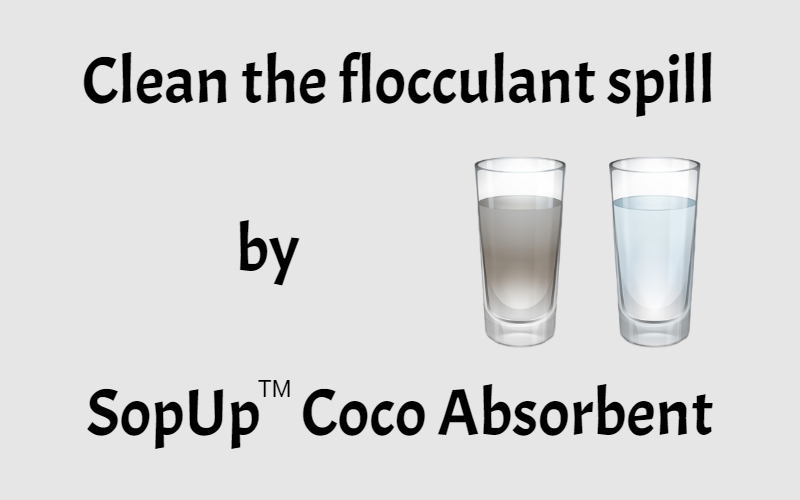Clean the flocculant spills by SopUpTM Coco Absorbent
Flocculation is a process where accumulated particles or deposits are withdrawn, it is basically a process of separation of a solution. The term flocculation is derived from floc, referring to the flakes of a component.
When a flocculating agent is added to a solution, the smaller residues get converted into a larger cluster which can be easily extracted from the solution. This can happen naturally but sometimes needs to be forced by adding flocculants.
Why are Flocculants of importance?
The element which enhances the agglomeration of smaller deposits existing in a solution, resulting in a floc which either floats or sinks is called flocculant. The flocs can be easily withdrawn from the solution.
The flocculants can be either organic or inorganic. They are available in different charges, densities, mass and forms.
The popular ones are organic polymeric flocculants because of their capacity to establish the process with minimum quantity. But because it is not a biodegradable component, biopolymers are more in use as they are eco-friendly.
Since the shelf-life of biopolymers is shorter and needs a higher quantity to enhance the process, scientists have come up with a combination where synthetic polymers are embedded with natural polymers which gives rise to an improved type of flocculant with ideal benefits.
The proper combination depends on the type of the particles to be removed and also the process of sinking or floating which is known as sedimentation of floatation.
Uses of flocculants
Different industries like civil engineering companies, cheese makers, biotechnology, earth science and breweries include flocculants. It is most widely used in the wastewater treatment industry for solids dehydration, removal of solids, water clarification, lime softening and sludge thickening.
Since 2000 BC the process of purification of water using flocculants has been in existence. The colloidal particles like clay, bacteria, plankton, decaying plant materials, or any other materials will be present in water which has to be removed. Egyptians used vessels which are covered with smeared almonds to purify water.
This process is used currently in the purification of drinking water, stormwater, industrial wastewater treatment etc.
Mechanism:
Based on the solution that has to be purified or separated, flocculants are used all alone or maybe in combination with the coagulants. This varies according to the chemical composition or charge of the solution.
Destabilization of the particles in a stable solution will be done by coagulants which makes the particles aggregate and creates a bonding whereas flocculants combine with the particles and forms a cluster called floc which will either float or sink in the solution and be removed from the solution.
Drawbacks of using flocculants
The major drawback of the flocculants is when it spills down on the floor or any surface, it creates a large mess when it comes in contact with water.
When combined with water it dissolves and forms a highly viscous gel kind of material which makes the floor slippery. It is essential to clean the residues.
Hence flocculants should be used in tiny amounts ( less than 0.1%) with large quantities of water.
SopUp absorbent for flocculant spills.
SopUp absorbent being non-toxic and organic is the best product for cleaning up flocculant spills.
Whenever there is a spill, usage of clay-based absorbent may glaze the spill and when disposing only of the clay will be removed but not the slippery residue. Also, clay-based absorbants are health hazards and carcinogenic.
Using SopUp absorbant makes it free from the residue sticking on the floor and also as it is naturally made, no ri8sk of health issues.
How to use SopUp absorbant for flocculant spills:
- Step 1: Spread the SopUp absorbant of the spilled area. Cover the entire surface including all the edges of the spill.
- Step 2: After spreading the SopUp absorbent on the spilled surface, broom the absorbent all over the surface until the fluid has been absorbed and ensure that no residue is left.
- Step 3: Gather all the absorbent and transfer it in a bag using a brush or broom. If the spill is in minimum quantity the absorbent can be reused again.
- Step 4: After the 3rd step a little more absorbant can be added and swept to remove if there is additional residue.
- Step 5: Dispose the used SopUp absorbant according to the protocols for the polymers that have been absorbed.
